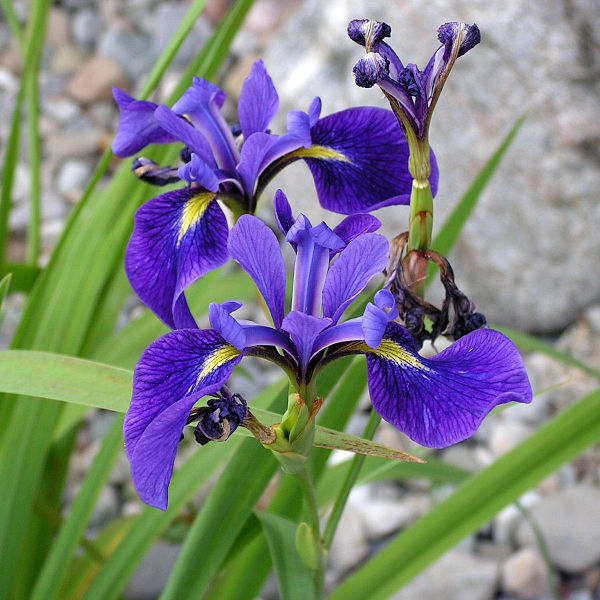Blue Flag
What’s in this blog category?
Latin Names:
Iris Versicolor
Common Names:
Blue Flag, Harlequin Blueflag, Northern Blueflag
General Information:
Blue Flag is a perennial flowering plant native to North America. – It is known for its vibrant blue or purple flowers and distinctive sword-shaped leaves. It can be found in wetland habitats across North America, from Canada to the United States.
The plant is associated with symbolism such as purification, healing, and spirituality and has been historically used by indigenous people of North America for healing. The plant contains potentially toxic compounds should only be used with guidance from a qualified healthcare practitioner.

Cultivation & Foraging:
Identification:
Blue Flag has long, erect leaves that are sword-shaped and folded along the midrib. It produces showy flowers with six petals in shades of blue, purple, or occasionally white. The plant typically grows to a height of 1 to 3 feet (30 to 90 cm).
Ecological Benefits:
Blue flag helps stabilize wetland soils and provides habitat for various wildlife including pollinators like bees and butterflies. The plant’s rhizomes and fibrous roots aid in soil erosion control and water filtration.
Blue Flag plays a role in supporting wetland ecosystems. It thrives in moist to wet habitats, such as marshes, swamps, and along the edges of ponds and streams.
Planting:
Prepare a moist or wet planting site with rich, loamy soil. Plant the seeds at a depth of about 1/4 inch (6 mm). Sow Blue Flag seeds in the fall or early spring.
Special Growing Conditions:
Blue Flag seeds may benefit from a period of cold stratification to break dormancy. Consider providing a cold stratification period of several weeks before planting.
Germination Time:
Seeds usually take between 30 and 180 days to germinate.
Pests & Disease:
Blue flag can be succeptible to root rot, soft rot, dry rot, powdery mildew and leaf spot.
Companion Plants:
Consider planting Blue Flag alongside other wetland plants such as Marsh Marigold, Cardinal Flower, or Joe-Pye Weed.
Harvest & Culinary Use:
Parts to Harvest:
Blue Flag seeds can be harvested from mature seed pods in late summer or early fall. Store them in a cool, dry place.
The rhizomes (underground stems) of Blue Flag are typically harvested for medicinal purposes.
Harvesting Time:
Harvest the rhizomes in the fall or early spring when the plant is dormant.
Preservation:
Harvest the rhizomes in the fall or early spring when the plant is dormant.
Culinary Use
Harvest the rhizomes in the fall or early spring when the plant is dormant.
Medicinal Use:
Medicinal Overview:
Blue Flag has a history of traditional use by Indigenous peoples of North America, who employed it for various purposes, including as a diuretic, expectorant, and to treat skin conditions. Blue Flag contains potentially toxic compounds and should not be used without proper knowledge or guidance from a qualified healthcare professional. Pregnant and breastfeeding women should avoid the use of Blue Flag due to its potential toxicity.
Blue Flag has a history of traditional use by Indigenous peoples of North America, who employed it for various purposes, including as a diuretic, expectorant, and to treat skin conditions.
Blue Flag contains potentially toxic compounds and should not be used without proper knowledge or guidance from a qualified healthcare professional. Pregnant and breastfeeding women should avoid the use of Blue Flag due to its potential toxicity.
Anti-inflammatory properties:
Blue Flag contains compounds that have been found to exhibit anti-inflammatory activity. For example, a study published in the Journal of Ethnopharmacology in 2003 demonstrated the anti-inflammatory effects of Blue Flag extract in laboratory experiments using animal models.
Dangers:
Blue Flag contains potentially toxic compounds and should not be used without proper knowledge or guidance from a qualified healthcare professional.
Disclaimer
The information provided on this website regarding the growing, harvesting, preparation, and consumption of plants is for general informational purposes only. It is not intended to be a substitute for professional advice, diagnosis, or treatment. Always seek the advice of a qualified expert or professional before engaging in any activities related to plants. The website owner and authors make no representations or warranties of any kind, express or implied, about the completeness, accuracy, reliability, suitability, or availability of the information contained on this website. Any reliance you place on such information is strictly at your own risk. The website owner and authors disclaim any liability for any errors or omissions in the content of this website. In no event shall they be liable for any special, direct, indirect, consequential, or incidental damages or any damages whatsoever, whether in an action of contract, negligence, or other tort, arising out of or in connection with the use of the information provided on this website. The website may include links to external websites that are not controlled or maintained by the website owner or authors. The inclusion of any external links does not necessarily imply a recommendation or endorsement of the views expressed within them. The information presented on this website may not be applicable or accurate in all jurisdictions. It is your responsibility to comply with all applicable laws and regulations regarding the growing, harvesting, preparation, and consumption of plants in your jurisdiction. By using this website, you agree to indemnify, defend, and hold harmless the website owner and authors from any claims, damages, liabilities, costs, or expenses arising out of your use of the information provided on this website. This legal disclaimer is subject to change without notice, and any changes will be effective immediately upon posting.
